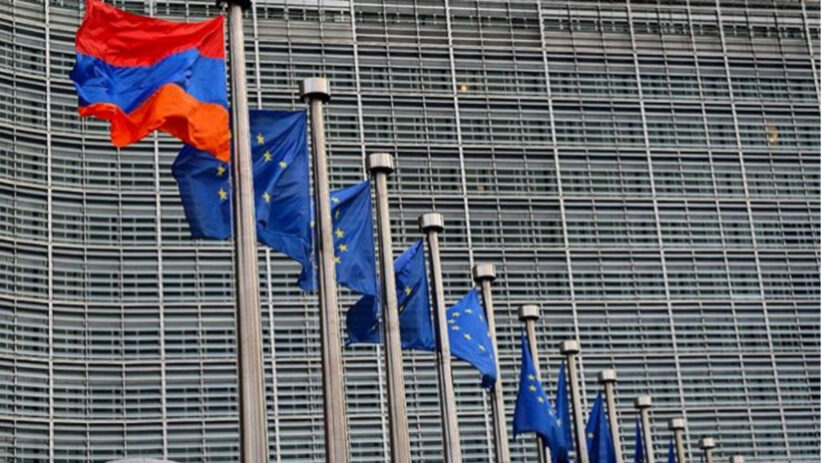By Mark Dovich
Armenia will exit a European Union preferential trade regime next month, having been classified as an upper middle income country for three consecutive years by the World Bank.
Under the EU’s Generalized Scheme of Preferences Plus program, Brussels had granted Yerevan full tariff removal on over 6,000 eligible products. Armenia first joined GSP+ in 2009.
In 2020, Armenia exported €128 million of goods to the EU under GSP+. That is more than three times higher than the €42 million of goods that Armenia exported to the EU when it joined the reformed program seven years ago. (In 2019, before the COVID-19 pandemic upended the global economy, Armenia hit a record of €197 million of exports to the EU under GSP+.)
More than 96% of Armenia’s exports to the EU under GSP+ are base metals, according to European Commission data. The EU defines base metals to include aluminum, copper, lead, tin, and zinc. The mineral industry plays a leading role in Armenia’s economy, and the country enjoys considerable deposits of copper, gold, and molybdenum.
According to European Commission figures, about 18% of Armenia’s total trade last year was with the EU, making the bloc one of Armenia’s largest export markets.
What is GSP+?
The EU’s Generalized Scheme of Preferences unilaterally offers reduced tariffs to developing countries that export to the EU in order “to alleviate poverty and create jobs based on international values and principles, including labour and human rights,” according to the European Commission.
The EU’s GSP originates in World Trade Organization rules based on the 1971 UNCTAD trade initiative, under which developed countries and blocs, like the EU, can offer developing countries non-reciprocal preferential treatment in trade. The EU’s GSP is “widely recognised as the most progressive in terms of coverage and benefits,” according to the European Commission.
Armenia and eight other countries currently benefit from GSP+ arrangements with the EU: Bolivia, Cape Verde, Kyrgyzstan, Mongolia, Pakistan, the Philippines, Sri Lanka, and Uzbekistan.
Why is Armenia leaving?
In order to qualify for GSP+, countries must ratify 27 international conventions on human rights, labor rights, environmental protection, and good governance. They must also meet a set of vulnerability criteria, meaning that they are classified by the World Bank as having an income below upper middle income and have non-diversified economies with low levels of exports to the EU.
Armenia’s exit, or “graduation,” from the program stems from its income level classification by the World Bank, which has considered Armenia to be an upper middle income country since 2017. (The World Bank previously classified Armenia as a lower middle income country, based on gross national income per capita.) Under EU rules, any GSP+ beneficiary country that has been classified as such by the World Bank for three consecutive years loses program eligibility.
In December 2020, the European Commission officially determined that Armenia had reached upper middle income status and, in accordance with EU regulation, granted Armenia a one-year transition period, which ends next month.
The last country to graduate from GSP+ was Paraguay, which exited the program in 2019 after being classified by the World Bank as an upper middle income country in 2015, 2016, and 2017.
What happens next?
Starting in January, Armenia will begin trading with the EU on the basis of a Comprehensive and Enhanced Partnership Agreement. The EU’s CEPA with Armenia entered into force in March and covers a “wide range of areas,” including political and economic issues, according to the European Commission.
As a result of leaving GSP+, Armenia “will face significantly higher import tariffs at the EU” and “it will be more difficult for [Armenian] exporters to enter the EU market with new products,” according to a 2020 study by the German consulting group Berlin Economics.
According to the study, Armenia’s graduation from GSP+ raises “the EU simple average import duty from 0.8% to 5.1%,” which it calls a “strong increase.” The report predicts a 20% reduction in Armenian exports to the EU year-on-year, with the textile and apparel sector expected to be particularly hard-hit.
The study suggests that affected Armenian businesses can reorient their exports to other markets in order to mitigate the negative impacts of Armenia’s exit from GSP+.
But Karen Azaryan, a trade officer with the EU Delegation to Armenia, argued that affected businesses can also respond by working to improve their productivity and efficiency.
“The affected businesses could respond by working to improve their productivity and efficiency. Reduction of production costs would enable producers to stay competitive at the EU market, even with increased duties,” he said. “In particular, modernization of technologies and equipment, as well as training of staff, could increase the effectiveness of production and lead to the reduction of expenses.”
In a recent CivilNet interview, Deputy Minister of Economy Arshak Aslanyan, also expressed confidence that Armenian businesses will be able to weather Armenia’s exit from GSP+.
“Discontinuation of GSP+ will, of course, have a short-term effect. Producers who do not manage to rearrange will have problems. In that case, they [can] approach the Ministry of Economy,” he said. “We [will] support, give directions, [and] negotiate with governments.”
Read the article in Armenian.
















